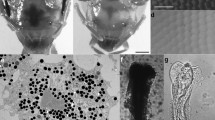Summary
According to a hypothesis of Wald (1958), the SH-groups appearing during the photo-chemical reaction of the rhodopsin are possibly to be made responsible for the receptor potential of the retinal cells.
From this concept a quantitative correlation is deduced between receptor potential, exposure time and the intensity of the exposure light.
Measurements are made of the receptor potentials from individual retinal cells of the fly, varying hereby the depth of penetration and the intensity of the exposure light.
The results are the following:
-
1.
The receptor potentials show a graduation in direction of the long axis of the cell. During the exposure, the distal part of the retinal cell shows the greatest depolarisation and the proximal part the lowest one. This fact gives a satisfying interpretation for the occurrence of an electroretinogram beyond the scope of the theme dealt with here.
-
2.
The calculated linear course of the increasing flank of the receptor potential may be confirmed for small intervals of time.
-
3.
Due to the theoretical considerations, a linear correlation is to be expected between the slope of the increasing flank and the intensity of the exposure light. The measurements confirm this correlation for light intensities smaller than 1 Lux.
Zusammenfassung
Nach einer Hypothese von Wald (1958) sind die bei der photochemischen Reaktion des Rhodopsins auftretenden SH-Gruppen unter Umständen für das Belichtungspotential der Sehzellen verantwortlich zu machen.
Es wird auf Grund dieser Vorstellung ein quantitativer Zusammenhang hergeleitet zwischen Belichtungspotential, Belichtungszeit und der Intensität des Reizlichtes.
Gemessen werden Belichtungspotentiale von einzelnen Sehzellen der Fliege, wobei Einstichtiefe und eingestrahlte Intensität variiert werden.
Es ergibt sich:
-
1.
Die Belichtungspotentiale zeigen eine Graduierung in Richtung der Zellenlängsachse. Der distale Teil der Sehzelle wird bei Belichtung am stärksten depolarisiert, der proximale am schwächsten. Diese Tatsache liefert außerhalb des Rahmens der hier zugrunde liegenden Aufgabenstellung eine befriedigende Erklärung für das Auftreten eines Elektroretinogramms.
-
2.
Der errechnete lineare Verlauf der Anstiegsflanke des Belichtungspotentials kann für kleine Zeitintervalle bestätigt werden.
-
3.
Nach den theoretischen Überlegungen ist zwischen der Steilheit der Anstiegsflanke und der Intensität des Reizliohtes ebenfalls ein linearer Zusammenhang zu erwarten. Die Messungen bestätigen diesen Zusammenhang für Beleuchtungsstärken von kleiner als 1 Lux.
Similar content being viewed by others
Literatur
Autrum, H.: Electrophysiological analysis of the visual system in insects. Exp. Cell Res., Suppl. 5, 426–439 (1958).
Burkhardt, D., u. H. Autrum: Die Belichtungspotentiale einzelner Sehzellen von Calliphora erythrocephala Meig. Z. Naturforsch. 15, 612–616 (1960).
Exner, S.: Die Physiologie der facettierten Augen von Krebsen und Insekten. Leipzig u. Wien: Franz Deuticke 1891.
Fernández-Morán, H.: Fine structure of the light receptors in the compound eyes of insects. Exp. Cell Res., Suppl. 5, 586–644 (1958).
Goldsmith, T. H.: The visual system of insects. In: The physiology of insecta, p. 419–422 (Morris Rockstein ed.). New York and London:Academic Press 1964.
Hagins, W. A.: Electrical signs of information flow in photoreceptors. Cold. Spr. Harb. Symp. quant. Biol. 30, 403–418 (1965).
—, H. V. Zonana, and R. G. Adams: Local membrane current in the outer segments of squid photoreceptors. Nature (Lond.) 194, 844–847 (1962).
Hodgkin, A. L.: Ionic movements and electrical activity in giant nerve fibres. Proc. roy. Soc. 148, 1–37 (1958).
Hubbard, R., D. Bownds, and T. Yoshizawa: The chemistry of visual photoreception. Cold Spr. Harb. Symp. quant. Biol. 30, 301–315 (1965).
Langer, H.: Spektrometrische Untersuchungen der Absorptionseigenschaften einzelner Rhabdomere im Facettenauge. Verh. dtsch. zool. Ges. 59, 329–337 (1966).
Stieve, H.: Interpretation of the generator potential in terms of ionic processes. Cold Spr. Harb. Symp. quant. Biol. 30, 451–456 (1965).
Wald, G.: Photochemical aspects of visual excitation. Exp. Cell Res., Suppl. 5, 389–410 (1958).
—, and P. K. Brown: Human color vision and color blindness. Cold Spr. Harb. Symp. quant. Biol. 30, 345–361 (1965).
Author information
Authors and Affiliations
Additional information
Diese Arbeit ist meinem verehrten Lehrer, Herrn Prof. Dr. H. Autrum, in Dankbarkeit zu seinem 60. Geburtstag gewidmet.
Für die Untersuchungen sind Apparaturen verwendet worden, die die Deutsche Forschungsgemeinschaft Herrn Prof. Dr. Autrum zur Verfügung gestellt hat.
Rights and permissions
About this article
Cite this article
Zettler, F. Analyse der Belichtungspotentiale der Sehzellen von Calliphora erythrocephala Meig. Zeitschrift für vergleichende Physiologie 56, 129–141 (1967). https://doi.org/10.1007/BF00340505
Received:
Issue Date:
DOI: https://doi.org/10.1007/BF00340505




